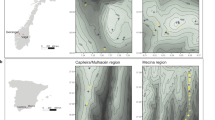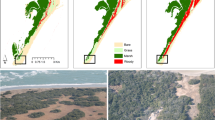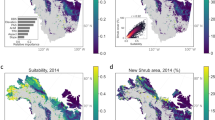Abstract
Rapid climate warming in the tundra biome has been linked to increasing shrub dominance1,2,3,4. Shrub expansion can modify climate by altering surface albedo, energy and water balance, and permafrost2,5,6,7,8, yet the drivers of shrub growth remain poorly understood. Dendroecological data consisting of multi-decadal time series of annual shrub growth provide an underused resource to explore climate–growth relationships. Here, we analyse circumpolar data from 37 Arctic and alpine sites in 9 countries, including 25 species, and ∼42,000 annual growth records from 1,821 individuals. Our analyses demonstrate that the sensitivity of shrub growth to climate was: (1) heterogeneous, with European sites showing greater summer temperature sensitivity than North American sites, and (2) higher at sites with greater soil moisture and for taller shrubs (for example, alders and willows) growing at their northern or upper elevational range edges. Across latitude, climate sensitivity of growth was greatest at the boundary between the Low and High Arctic, where permafrost is thawing4 and most of the global permafrost soil carbon pool is stored9. The observed variation in climate–shrub growth relationships should be incorporated into Earth system models to improve future projections of climate change impacts across the tundra biome.
This is a preview of subscription content, access via your institution
Access options
Subscribe to this journal
Receive 12 print issues and online access
$209.00 per year
only $17.42 per issue
Buy this article
- Purchase on Springer Link
- Instant access to full article PDF
Prices may be subject to local taxes which are calculated during checkout



Similar content being viewed by others
Change history
06 August 2015
In the version of this Letter originally published online, the second affiliation for Martin Hallinger was missing: 7Department of Ecology, Swedish University of Agricultural Sciences, PO Box 7044, 75007 Uppsala, Sweden. The remaining affiliations have been renumbered. In the Acknowledgements, the following information should have been included for M.H.: ‘..., EU ATANS Grant FP6506004 and the scholarship programme of the German Federal Environment Foundation (no. 20008/983) (M.H.)’. These errors have been corrected in all versions of the Letter.
References
Elmendorf, S. C. et al. Plot-scale evidence of tundra vegetation change and links to recent summer warming. Nature Clim. Change 2, 453–457 (2012).
Myers-Smith, I. H. et al. Shrub expansion in tundra ecosystems: Dynamics, impacts and research priorities. Environ. Res. Lett. 6, 045509 (2011).
Tape, K. D., Sturm, M. & Racine, C. H. The evidence for shrub expansion in Northern Alaska and the Pan-Arctic. Glob. Change Biol. 12, 686–702 (2006).
IPCC Climate Change 2014: Impacts, Adaptation, and Vulnerability (eds Field, C. B. et al.) (Cambridge Univ. Press, 2014).
Chapin, F. S. et al. Role of land-surface changes in Arctic summer warming. Science 310, 657–660 (2005).
Blok, D. et al. Shrub expansion may reduce summer permafrost thaw in Siberian tundra. Glob. Change Biol. 16, 1296–1305 (2010).
Hinzman, L. D. et al. Trajectory of the Arctic as an integrated system. Ecol. Appl. 23, 1837–1868 (2013).
Pearson, R. G. et al. Shifts in Arctic vegetation and associated feedbacks under climate change. Nature Clim. Change 3, 673–677 (2013).
Hugelius, G. et al. The Northern Circumpolar Soil Carbon Database: Spatially distributed datasets of soil coverage and soil carbon storage in the northern permafrost regions. Earth Syst. Sci. Data 5, 3–13 (2013).
Tape, K., Hallinger, M., Welker, J. & Ruess, R. Landscape heterogeneity of shrub expansion in Arctic Alaska. Ecosystems 15, 711–724 (2012).
IPCC Climate Change 2013: The Physical Science Basis (eds Stocker, T. F. et al.) (Cambridge Univ. Press, 2013).
Post, E. et al. Ecological dynamics across the Arctic associated with recent climate change. Science 325, 1355–1358 (2009).
Forbes, B. C., Macias-Fauria, M. & Zetterberg, P. Russian Arctic warming and ‘greening’ are closely tracked by tundra shrub willows. Glob. Change Biol. 16, 1542–1554 (2010).
Macias-Fauria, M., Forbes, B. C., Zetterberg, P. & Kumpula, T. Eurasian Arctic greening reveals teleconnections and the potential for structurally novel ecosystems. Nature Clim. Change 2, 613–618 (2012).
Sturm, M., Racine, C. H. & Tape, K. D. Increasing shrub abundance in the Arctic. Nature 411, 546–547 (2001).
Hallinger, M., Manthey, M. & Wilmking, M. Establishing a missing link: Warm summers and winter snow cover promote shrub expansion into alpine tundra in Scandinavia. New Phytol. 186, 890–899 (2010).
Blok, D. et al. What are the main climate drivers for shrub growth in Northeastern Siberian tundra? Biogeosciences 8, 1169–1179 (2011).
Weijers, S. et al. No divergence in Cassiope tetragona: Persistence of growth response along a latitudinal temperature gradient and under multi-year experimental warming. Ann. Bot. 110, 653–665 (2012).
Wullschleger, S. D. et al. Plant functional types in Earth system models: Past experiences and future directions for application of dynamic vegetation models in high-latitude ecosystems. Ann. Bot. 114, 1–16 (2014).
Ettinger, A. K., Ford, K. R. & HilleRisLambers, J. Climate determines upper, but not lower, altitudinal range limits of Pacific Northwest conifers. Ecology 92, 1323–1331 (2011).
HilleRisLambers, J., Harsch, M. A., Ettinger, A. K., Ford, K. R. & Theobald, E. J. How will biotic interactions influence climate change-induced range shifts? Ann. NY Acad. Sci. 1297, 112–125 (2013).
MacArthur, R. H. Geographical Ecology: Patterns in the Distribution of Species (Princeton Univ. Press, 1972).
Grime, J. P. Evidence for the existence of three primary strategies in plants and its relevance to ecological and evolutionary theory. Am. Nat. 111, 1169–1194 (1977).
Seneviratne, S. I. et al. Investigating soil moisture–climate interactions in a changing climate: A review. Earth Sci. Rev. 99, 125–161 (2010).
Wilmking, M. & Myers-Smith, I. Changing climate sensitivity of black spruce (Picea mariana Mill.) in a peatland-forest landscape in Interior Alaska. Dendrochronologia 25, 167–175 (2008).
Elmendorf, S. C. et al. Global assessment of experimental climate warming on tundra vegetation: Heterogeneity over space and time. Ecol. Lett. 15, 164–175 (2012).
Harsch, M. A., Hulme, P. E., McGlone, M. S. & Duncan, R. P. Are treelines advancing? A global meta-analysis of treeline response to climate warming. Ecol. Lett. 12, 1040–1049 (2009).
Beck, P. S. A. et al. Changes in forest productivity across Alaska consistent with biome shift. Ecol. Lett. 14, 373–379 (2011).
Olofsson, J. et al. Herbivores inhibit climate-driven shrub expansion on the tundra. Glob. Change Biol. 15, 2681–2693 (2009).
Bret-Harte, M. S., Shaver, G. R. & Chapin, F. S. Primary and secondary stem growth in Arctic shrubs: Implications for community response to environmental change. J. Ecol. 90, 251–267 (2002).
Acknowledgements
We thank the many field and laboratory assistants for help with data collection, and the governments, parks, field stations and local and indigenous people for the opportunity to conduct research on their land. Financial support was provided by the International Arctic Science Committee (All), German Centre for Integrative Biodiversity Research (iDiv) Halle-Jena-Leipzig (sTUNDRA working group), the EnviroNorth CREATE grant (I.H.M.-S.), International Polar Year Programs of the Government of Canada, Natural Sciences and Engineering Research Council of Canada and Northern Scientific Training Program (I.H.M.-S., D.S.H., M.V., S.A.R., N.B.-L., E.L., A.J.T., L.H., L.S.C., T.C.L.), INTERACT (262693), 7th Framework Programme, Virtual Institute ICLEA of the Helmholtz Foundation (M.W. and A.Buras), Wageningen University and Research Center, Darwin Center for Biogeosciences, Danish National Research Foundation (CENPERM DNRF100) (D.B.), Swedish Polar Secretariat (S.A.R.), Academy of Finland, Nordic Centre of Excellence TUNDRA, NASA Land Cover/Land-Use Change Program (B.C.F. and M.M.-F.), Natural Environment Research Council Independent Research Fellowship (NE/L011859/1) (M.M.-F.), Research Council of Norway (Project 212897) (J.D.M.S.), Fonds de recherche du Québec: Nature et technologies (N.B.-L., E.L., M.V.) and Centre d’études Nordiques, ArcticNet—a network of centres of excellence (S.A.R., N.B.-L., E.L., A.J.T., L.H., L.S.C.), Polar Continental Shelf Program (S.A.R., N.B.-L., E.L.), Canada Foundation for Innovation (T.C.L.), WSL Institute for Snow and Avalanche Research SLF (to C.R., M.A.D., J.A.W., S.Wipf), Knud Højgaard Charity Foundation (N.M.S.), The Northern Worlds initiative of the National Museum of Denmark (C.B.), IPY-NWO (project 851.40.051) (S.Weijers), Polish National Science Centre (project N306 009139) (A.Buchwal), Virtual Institute ICLEA of the Helmholtz Foundation (A.Buras), National Science Foundation (ARC-0806506) (A.T.N.), University of Zurich Research Priority Program ‘Global Change and Biodiversity’ (G.S.-S.), Woods Hole Research Center (K.C.G.), The Research Council of Norway (V.R.), EU ATANS Grant FP6506004 and the scholarship programme of the German Federal Environment Foundation (no. 20008/983) (M.H.).
Author information
Authors and Affiliations
Contributions
All authors designed the study, collected or processed data and assisted in writing the paper; I.H.M.-S. and M.V. took the lead in writing the paper; I.H.M.-S. analysed the data with assistance from S.C.E.
Corresponding author
Ethics declarations
Competing interests
The authors declare no competing financial interests.
Supplementary information
Rights and permissions
About this article
Cite this article
Myers-Smith, I., Elmendorf, S., Beck, P. et al. Climate sensitivity of shrub growth across the tundra biome. Nature Clim Change 5, 887–891 (2015). https://doi.org/10.1038/nclimate2697
Received:
Accepted:
Published:
Issue Date:
DOI: https://doi.org/10.1038/nclimate2697
This article is cited by
-
From Intra-plant to Regional Scale: June Temperatures and Regional Climates Directly and Indirectly Control Betula nana Growth in Arctic Alaska
Ecosystems (2023)
-
Hydrological Regime and Plant Functional Traits Jointly Mediate the Influence of Salix spp. on Soil Organic Carbon Stocks in a High Arctic Tundra
Ecosystems (2023)
-
Tundra vegetation change and impacts on permafrost
Nature Reviews Earth & Environment (2022)
-
The changing thermal state of permafrost
Nature Reviews Earth & Environment (2022)
-
Alpine shrub growth follows bimodal seasonal patterns across biomes – unexpected environmental controls
Communications Biology (2022)



